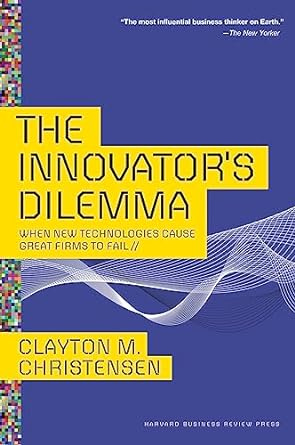The Innovator’s Dilemma explores why successful companies often fail when confronted by disruptive technologies. Clayton M. Christensen examines how businesses that dominate their industries—by excelling in serving their existing customers and improving their products—can be overtaken by newer, smaller competitors. These disruptors introduce simpler, cheaper, and more accessible solutions that appeal to emerging or overlooked markets.
Christensen introduces the concept of disruptive innovation, emphasizing that traditional strategies of sustaining growth often prevent established firms from embracing transformative technologies. The book offers key insights into identifying potential disruptors and strategies to adapt and thrive in the face of change.
With real-world case studies, Christensen provides a framework for managers and leaders to navigate the tension between maintaining current success and embracing innovation. Whether you’re a CEO, entrepreneur, or investor, this book will transform the way you think about competition, innovation, and business survival.
Here are seven big ideas from The Innovator’s Dilemma by Clayton M. Christensen:
Disruptive Innovation: Disruptive technologies initially underperform compared to existing solutions but succeed because they meet the needs of overlooked or emerging markets. Established firms often ignore these innovations until it’s too late.
Sustaining vs. Disruptive Technologies: Sustaining technologies improve existing products for mainstream customers. Disruptive technologies, on the other hand, create new markets or transform existing ones by offering simpler, cheaper, or more convenient solutions.
The Innovator’s Dilemma: Successful companies focus on satisfying their current customers and maintaining profitability, which makes them reluctant to invest in disruptive innovations that don’t immediately appeal to their core markets.
Market Overserving: As companies continually improve their products, they often exceed the needs of their customers. This over-serving creates opportunities for disruptors to enter the market with simpler, more affordable alternatives.
The Importance of Organizational Structure: A company’s processes and values can limit its ability to embrace disruptive innovations. To compete effectively, organizations must sometimes create separate teams or spin-offs to explore disruptive opportunities.
Listening to Customers Isn’t Always Best: Focusing solely on current customers’ demands can prevent companies from noticing or investing in emerging technologies that could disrupt their market.
Balancing Short-term Profitability and Long-term Survival: Firms must balance the immediate financial benefits of optimizing current products with the long-term need to innovate and adapt to disruptive changes.











